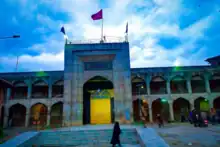| Imambara Qadeem Qadibal | |
|---|---|
Marak | |
 Imambara Qadeem Zadibal | |
| Religion | |
| Affiliation | Islam(Shia) |
| Sect | Shia Islam |
| Location | |
| Location | Zadibal, Srinagar, Kashmir |
 Shown within Jammu and Kashmir | |
| Geographic coordinates | 34°6′38″N 74°48′10″E / 34.11056°N 74.80278°E |
| Architecture | |
| Type | Imambara |
| Style | Persian |
| Date established | 1518 |

Imambara Zadibal was the first Imambara or Marak constructed in Kashmir Valley by Kaji Chak, minister in the regime of Sultan Mohammad in the year 1518. It is situated in the Zadibal area of Srinagar to the west side of Hari Parbat fort. This Imambara was burned down and destroyed number of times.[1][2][3]
Architecture
Inspired by the Persian style of architecture, Imambara Zadibal is a two-storey building. Its Maharaji bricks cover an area of over 75 square meters. This shrine has various sideways floor raisings called Gulam Gardish. There is a central ground level floor called Pokhr. It also has a large gallery with four gates.
Currently, the structure is under the supervision of All Jammu and Kashmir Shia Association.[4]
Observances
Shia Muslims are a minority in Kashmir. During the first 10 days of Muharram, Imambada Zadibal becomes a centre of mourning and religious gathering (Majlis) in Zadibal. Azadars (Mourners) join in the mourning, usually from Bota Kadal, Lalbazar and ending on the day of Ashura with large Zuljanah procession and parades through the streets of Zadibal ending at Imambada Zadibal.[5][6] Mourning continues from first day of Muharram to third of the Islamic month Rabi al Awwal, after which Eid al Zahra, also known as Eid e Shuja, is celebrated. This marks the end of the two-month mourning period.[7]
Building and destruction
Imambara Zadibal has been destroyed and rebuilt many times. From the period of Sultan Nazuk Shah by Mirza Douglat in 1548 AD to the reign of Maharaja Ranbir Singh in 1872 AD, this shrine was burnt down around eleven times.
At the time Imambara Zadibal was constructed. However, Mirza Hyder Kashgari Douglat set this shrine on fire in 1548 AD. Daulat Chak began rebuilding it in 1551.
Zafar Kupawari set Imambara Zadibal on fire for the second time in 1553. It was burned down again in 1653 during the reign of Mughal Emperor Shah Jahan.
In 1682 AD, when Emperor Aurangzeb Alamgir ruled, Imambara Zadibal was set on fire again. In 1719 AD, it was burned down for the fifth time during the Mukhtawi Khan clash. It caught fire for the sixth time in 1748 AD. Again in 1763. Imambara Zadibal caught fire again in June 1801, during Afghan rule in Kashmir, just before Ashura.[1]
In July 1830, the shrine was the site of a massacre when Jammu and Kashmir were under Sikh rule. This same day, many Shias were cruelly murdered. This happened at Ali Park in Zadibal or Margibal.
Imambara Zadibal was rebuilt with the financial help sent by Nawab Hakim Mehndi Ali Khan, the prime minister of Awadh's King Nasir-ud-din Haider. This grant was sent to Haji Baqir Khan Irani, who passed on the duty of rebuilding this structure to Hatim Mir.
In September 1872, the building was again set ablaze under the rule of Maharaja Ranbir Singh. He was a Dogra Ruler of J&K. This time, the king gave considerable financial aid of about Rs. 3 lakhs to renovate the Imambara and restore it to its current prosperous condition.[1][4]
Location
Reaching this shrine is easy because it is close to Srinagar Highway. The Imambara is in the middle of Zadibal, and it is near the Khushal Sar Lake and Hari Parbat Fort that most people call Qilla. The nearest railway station is the Srinagar railway station. It is an hour's ride away by car. Sheikh ul Alam International Airport is only a few kilometers from the Imambara. Taxi services are also available within the city of Srinagar.[8]
References
- 1 2 3 "Imambara Zadibal - One of Oldest Mosques of Kashmir". www.discoveredindia.com. Retrieved 2023-08-03.
- ↑ "Imambara Zadibal Srinagar". kashmirhills. 2015-02-19. Retrieved 2023-08-03.
- ↑ "imam-baras". www.aalatravels.com. Retrieved 2023-08-04.
- 1 2 "Kashmir's Imambara's Are Finest Specimens of Indigenous Architecture". Kashmir Life. 2023-07-27. Retrieved 2023-08-04.
- ↑ Kasmir, Greater (2018-08-04). "Hussaini Majalis, processions mark Majalis Asad in Kashmir". Greater Kashmir. Retrieved 2023-08-07.
- ↑ "Main Ashoora procession to be allowed through traditional route only, on 10th Muharram tomorrow from Bota Kadal to Imambara, Zad". Kashmir Rays. Retrieved 2023-08-07.
- ↑ CT, News Desk (2023-07-27). "Historic 8th Muharram Procession Takes Place in Kashmir Valley After 34 Years". The Chenab Times. Retrieved 2023-08-08.
- ↑ "Historical Imambarah Qadeem Zadibal · Zadibal, Srinagar, Jammu and Kashmir 190011". Historical Imambarah Qadeem Zadibal · Zadibal, Srinagar, Jammu and Kashmir 190011. Retrieved 2023-08-04.